Alfred Silvester – the Fakir of Oolu and his Family of Magic
Chapter Eight – Charles Silvester, the New Fakir of Oolu and Eleanor Silvester, the Entranced Lady
Evading the Passage Money:-
Quite an exciting scene was witnessed at the Sydney Wharf the other day. The hands on one of the steamers were engaged in rolling off a cask, when, to their consternation and surprise, a voice was heard inside the cask : "Roll it easy; these darned nails hurt. I'd rather pay my passage than stand all this." Holding up their hands, with their eyes expanded to the size of two saucers, the men exclaimed, "This beats the devil." The mate, coming up at this moment, unaware of the cause of delay, began cursing them for their dilatoriness, when from within the cask the voice exclaimed, "Will nobody let me out of this cask ?"
" What's that ?" said the mate. "Why, it's me," said the voice. "I want to get out. I won't stand this any longer."
"Up-end that cask," said the mate. "Oh, don't; you'll kill me !" said the voice. "These darned nails prick me. Look out ! Don't !" said the casked-up individual, as the men were turning it over. "Cooper," said the mate, "unhead the cask, and take out that man." As the adze sundered the hoops, and the head was coming out, the voice again broke forth: "Rest easy now. Is there anyone about? I don't want to be caught."
Quite a crowd had now gathered around the scene of action, when, to the utter astonishment of the bystanders, a loud guttural laugh broke forth, which made their hair stand on end, and the cask was found filled with bacon!
"What does it mean?" said one. "It beats my time," said the mate. We enjoyed the joke too well to ‘blow’, as we walked off arm-in-arm with the "Fakir of Oolu," ventriloquist and magician.
- Colac Herald, December 10, 1886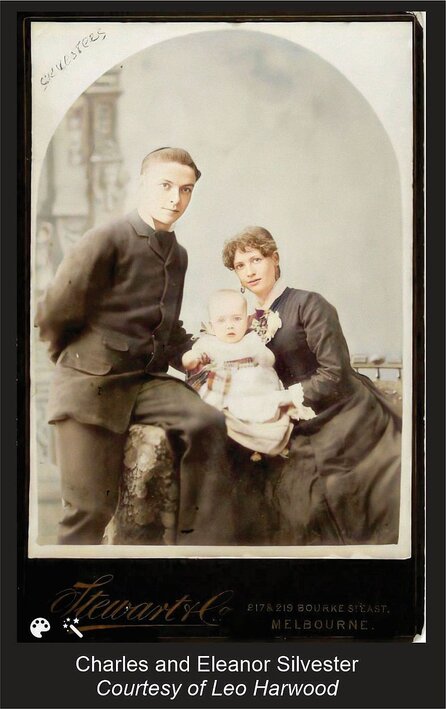

Charles Silvester may seem to have been a lesser character in the Silvester family of magic. His older brother, Alfred, was more noted as the magician and, perhaps, successor to the family title. Charles, however, had spent years working as Alfred senior’s principal assistant. He had toured to Asia, featured in the comic theatrical sketches using the ‘Enchanted Canopy’, and appeared as a featured artist in other ‘variety’ portions of the show including his own cornet solos and the Roller Skating act. He was fully conversant with every aspect of the show, and although it seemed that neither brother quite inherited Alfred1’s easy-going charm and bonhomie, he was well placed to continue in the theatre on his own account.
In terms of the family story, it should also be noted that despite Charles’ early and tragic death, it was through him that the Silvester family line can be traced to this day.
This is not a happy story. The supposed glamour of theatre is replaced by the daily struggle of performers to find ways of making a living, and to push forwards against adversity. Charles’ resilience, and his versatility as a performer, is equally mirrored by the career of his brother Alfred(2), and foreshadows the gutsy determination of the last of the magical Silvesters, Alfred William Silvester, in chapters yet to come.
1883 – Charles Marries Eleanor Whaley
At Adelaide on July 9, 1883, Charles married Eleanor Georgina Whaley (1863 – 1920), the second daughter of Horace Bennett Whaley. Eleanor was already travelling with the show and is mentioned in the Entranced Lady illusion as Miss E. Laroche, which stage-name she would continue to use although she was more commonly “Marie La Roche” or “Marie de la Roche” and every variation of spelling that could be invented by a lazy copy writer. Scarcely a month after the wedding, Alfred1 announced that the Silvester troupe was disbanding; and it appears that Charles had made a decision to step back from touring, and to focus on other business pursuits.
For the remainder of that year and into 1884, Charles is seen as a supplier of limelight to theatrical performances, using the improved technology developed by his father. (For ‘Blue Beard, or the Heathen Chinee’ at the Academy of Music, the press said “the manipulation of the limelights is worthy of a word of praise, the efforts of Professor Sylvester and his assistant, Mr H. Mack tending in no small degree to add to the effectiveness, and consequent success, of the performance.”)
Eleanor, meanwhile, had given birth to her first child, Charles Ernest Silvester. The young children would eventually be pressed into service as tiny performers in the family show; however only one girl, Vera, would continue as a performer. In order to keep some focus on the main story, the other children are detailed in Reference note (1).
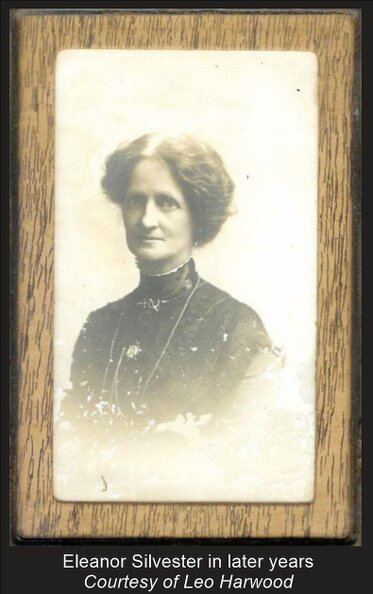
In both 1884 and 1885, Charles is scarcely visible in public circles, though he did perform his roller skating act at the Melbourne Opera House for a benefit event on July 10, 1884. The limelight business was one of his regular activities as late as 1889, and at the same time he was performing magic and managing roller skating rinks.
It was, however, the death of his father that brought Charles back to performing magic in 1886. The appearance is that Charles inherited the properties of Alfred’s show including the Fairy Fountain, and if one wished to follow the trail of the original mechanism for the Entranced Lady, it would be through Charles’ show. Alfred2 also had his own mechanism and, since the prop was not a complex piece of machinery, it is likely that several new versions were built over time. We will mention the mechanism in later chapters.
1886 – The New Fakir of Oolu
In Western Australia, Alfred2 was content to use his own name for performance purposes. With the passing of the original Fakir of Oolu, Charles now assumed the title and perpetuated a name which was familiar and popular with Australian audiences. It seems, also, that Charles may have intentionally promoted his name as “Sylvester” rather than “Silvester”, since that spelling is seen more often than before.
In early February 1886, he arrived in Sydney and announced an impending tour, but it was July before he was properly underway. Some performances given in Melbourne before his tour indicate that his repertoire was made up of practical smaller magic tricks with birds, fish and money. After a brief appearance, roller skating with the Anglo Statue Minstrels at the Nugget Theatre in Bourke Street, Charles and ‘Marie’ left on a tour of Victorian towns, in conjunction with Robert “Billy” Barlow.
In early February 1886, he arrived in Sydney and announced an impending tour, but it was July before he was properly underway. Some performances given in Melbourne before his tour indicate that his repertoire was made up of practical smaller magic tricks with birds, fish and money. After a brief appearance, roller skating with the Anglo Statue Minstrels at the Nugget Theatre in Bourke Street, Charles and ‘Marie’ left on a tour of Victorian towns, in conjunction with Robert “Billy” Barlow.
It is evident that Barlow was the lead star of the show – he was an iconic singer and original comedian of the Victorian goldfields, and immensely popular wherever he went. And so it proved for the company; they moved around Ballarat, Mt. Alexander, Kyneton and Bendigo between July and the end of October, Charles featuring both his magic and roller skating, and with Eleanor billed as the Lady Wizard, taking the part of the Entranced Lady. In every town the audiences were large and the press complimentary; “Barlow is as fresh as ever … kept the audience in a simmer of laughter while he was on stage … the Fakir of Oolu .. sleight of hand tricks were all neatly and cleverly performed and the exhibition of the entranced lady was an excellent manifestation … performed with a deftness that deceived the eye … Mr Sylvester’s roller-skating was also greatly admired…”
At Eaglehawk there was “not even standing room.” And so, with a successful tour under their belts, the Silvesters were able to return to Melbourne in November, to finish off the year performing in the Spanish and Columbian Festival held at the Exhibition Building.
The next couple of years would combine Charles’ full range of business activities – magic, theatrical lighting, and roller skating – and with three children born in the years 1884-1887, he and Eleanor led a relatively settled life away from touring.The first venture was into the newly-popular business of roller-skating rinks for the public; right in Charles’ line of expertise. Roller skating, first introduced to Australia by theatrical entrepreneur George Selth Coppin became so popular that by 1888 ‘Melbourne Punch’ devoted a regular column titled ‘Rinking’ to the activity. 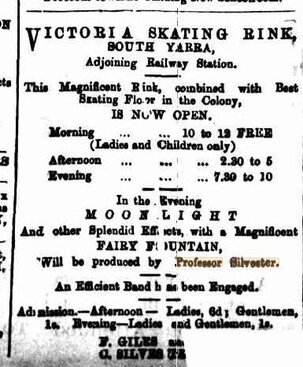

In July 1887, the concrete-floored Victorian Roller Skating Rink opened in Yarra Street near the South Yarra railway, and Charles was the manager. For the opening, he not only performed, but also provided the lighting effects and supplied the Fairy Fountain (which would be a regular attraction at the rink). The ‘Telegraph’ (2) reported,
“… should the proprietor, Mr. F. Giles, and his able and ingenious manager, Mr. Charles Silvester – better known as the Fakir of Oolu, the eminent illusionist – continue in conducting the establishment as they have begun, they need have no fear as to future success … The skates used at this rink are of an improved pattern, patented by Mr. Silvester, and are said to be capable of much greater velocity than those hitherto in use.”
From ‘Table Talk’ of July 29:
“… the elegant lettering suspended over the doors of the respective rooms and other places, which was the work of Professor Silvester, the manager of the rink, attracted much attention … Professor Silvester gave an exhibition of ‘travelling on wheels’ but in order to give the skaters as much time as possible on the splendid floor, he curtailed this portion of the programme. Some very charming lime-light effects were produced under this gentleman’s direction. First there was moonlight, succeeded by sunrise, then the light of a mid-summer day, changing to the light of a quiet evening .. the spectacle was very delightful and drew forth rounds of applause. Professor Silvester’s greatest achievement, however, was witnessed at the close of the evening, when he produced the ‘Fairy Fountain’ … assumed all kinds of fantastic forms, they changed from one colour to another, and the spectators applauded until the inventor of the fountain came forward and bowed his acknowledgments. The first ‘Fairy Fountain’ exhibited in Melbourne was by the late Fakir of Oolu, Professor Silvester’s father; and although it was much admired it is not too much to say that in this latest fountain, which was constructed expressly for the Victoria Rink, the son has greatly improved upon the work of the father.”
The start of 1888 saw the Silvesters back on the road to some extent. Advertising for the Fairy Fountain at the Victoria Rink ended in February, but already the Fakir with Madame de la Roche had removed the fountain across to Geelong where, from January, the ‘Juvenile and Industrial Exhibition’ was taking place. Eleanor was promoted as the ‘Female Prestidigitateur’, implying that she was more than just the assistant in the Entranced Lady illusion, and ‘Punch’ declared “her entertainment of mystery turned out one of the features at the Juvenile Exhibition.” The exhibition was still running in March when another magical feature was added – Professor S.S.Baldwin, the American magician and pseudo-clairvoyant.
After a brief appearance at Bendigo’s Easter Fair, the family relocated from Victoria to live in Sydney in April 1888, joining the bill at Hiscock’s Academy of Music in Castlereagh Street. Here, across two months, they promoted an illusion described as “Astarte” which, in usual magic terms, was the apparent levitation of a woman who would rotate in the air and move from one side of the stage to another. However that illusion was invented in 1889 and, reading the descriptions, “the lady wafted through mid-air by the aid of a fan only” and “Astarte will follow the Professor 12ft above the heads of the audience, defying the laws of gravity” it appears that this was still just the Entranced Lady with the original Fakir’s improvements.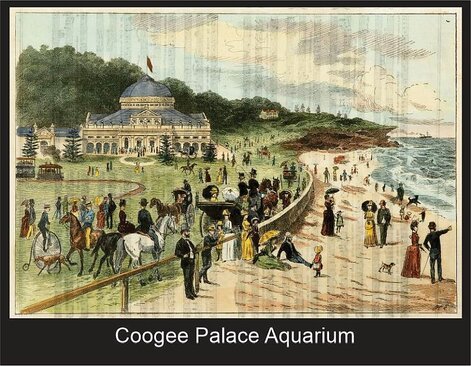

Charles, meanwhile, was establishing links with various roller skating venues in Sydney. The St.George’s Hall Skating Rink at Newtown (the building still exists, now under the use of the Newtown School of Performing Arts) featured the Fakir for several days in May.
Then, until the end of June the Silvesters seem to have been worked between two Aquariums / pleasure parks, both on the coast of Sydney, at beaches just south of Bondi Beach. The magic and skating acts were seen in May and June with great success.
Sadly, Anderson’s business overreach and a continued dispute over restricted beach access for swimmers saw the end of Wonderland in 1911, and Anderson was financially ruined.
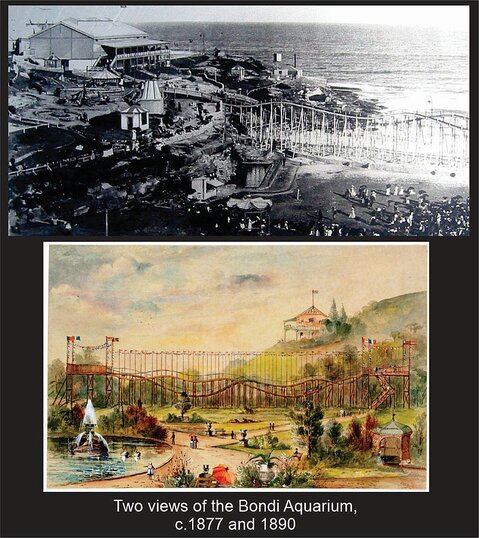
The Sydney Morning Herald (4) reported on a June performance at the Coogee Palace Aquarium:
“A lady wizard (Marie La Roche) performed some amusing conjuring tricks, being assisted by the ‘Fakir of Oolu,’ Mr. Charles Silvester, whose sleight of hand afforded also gratification to the spectators. An amazing quantity of coloured ribbon, about a dozen card-boxes, several balls, and baby linen sufficient to stock a small shop, was extracted from a gentleman’s hat, through the crown of which, apparently, a solid cube was immediately afterwards knocked …. The most remarkable feat performed, and one which excited much interest, was the suspension in the air, without visible support, of Marie La Roche … appropriate costume and a large pair of wings being attached to the aerial lady’s shoulders, whilst devoutly holding a cross to her breast … the entertainment concluded by a clever exhibition of fancy skating by Mr. Silvester.”Continuing his coverage of the major skating rinks in Sydney, Charles now took on the position of floor manager at the Crystal Palace Skating Rink in the middle of Sydney, at York Street next to the Opera House (at the site where now sits the grand Grace Hotel). In July he was providing “The Grand Eau De Cologne Fairy Fountain with Prismatic Limelight Effects”. Alas, in September it was reported that he had met with an accident by which he broke his knee cap, “totally unfitting him for work for a couple of months to come.” Charles was seen operating the lights, and making an appearance at a Christmas Concert at the Crystal Palace as the Fakir of Oolu, but otherwise he seems to have been out of action for the remainder of 1888.
March 1889 saw the Professor back on his skates at the Bondi Aquarium, and by August the family was preparing to make a performing tour heading north. They appeared in September at Newcastle’s Victoria Theatre, then Maitland, Singleton and Tamworth with varied success – in fact at Singleton only eight people arrived so their money was returned and the door shut. Better things awaited in Armidale where, at the Columbia Rink the house was large and the reception good. Possibly the show took in some small towns without newspaper publicity, and in late December 1889 the Armidale Express noted that ‘HILLGROVE MINES … for five nights the Fakir of Oolu has been at his wonders, wondering for his bread.’
HILLGROVE MINES
Hillgrove, just 34 Km from Armidale in northern New South Wales, was undergoing a boom in large-scale gold mining which resulted in the area being the richest gold-producing site in NSW, supplying 15,600 kilograms of gold over 32 years. Today it is a tiny town with small population, but at its peak there were 3,500 residents and many facilities – perhaps enticing Charles’ interest.
We have almost no information to say what was happening between 1890 and 1891, but a combination of facts, and a single photograph, indicate that Charles, in all likelihood, remained at Hillgrove and became either a miner, or a provider of services to the miners.
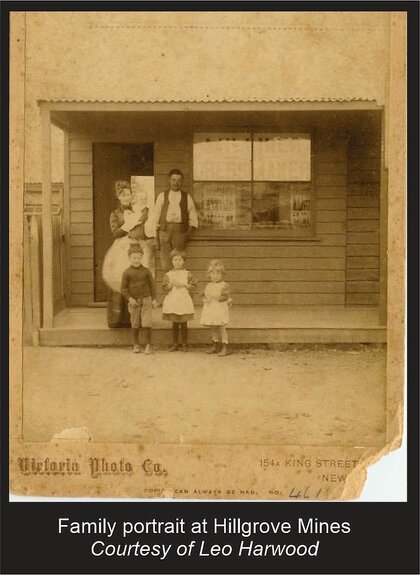
Nothing is seen of him in Sydney during 1890 and, when the “Bartelle Troupe” of trick cyclists went touring, they picked up Charles and Eleanor Silvester as performers in October, when they performed in Glen Innes (“one of the most amazing performances ever seen in Glen Inness” said the Examiner) and then barely across the Queensland border to work in Warwick, before the trail once again goes cold.
In 1891, “Marie La Roche” performed a solo act at the Old Town Hall, Armidale (April 1 and 2) in conjunction with the Reeves Family, who may have been locals. She presented many of the standard feats from the Silvester repertoire, including Blood Writing, Masks and Faces and the ‘Sealed Packet’ mystery. By May she was back in Sydney presenting a “Séance Spiritual” at Bondi Aquarium; but without any sign of Charles; and it was only in December, for appearances after Christmas, that he made a return to the Aquarium.
The strongest clue comes from a family photograph, posed in front of a small shopfront at Hillgrove. The shop window sign reads “Milliner Dressmaker” and a description pencilled on the rear reads:
Hillgrove Mines – via Armidale NSW – Monday December 22nd 1890 –
Ernest age 7 years & 20 days
May age 5 years & 4 months
Katie age 3 years & 8 months
Ida age 7 month & 13 days
Nell age 27 years & 8 months [pet name for Eleanor]
Charley age 32 years & 7 months
Brackin Street Hillgrove.
So it seems reasonable to conclude that Eleanor gave birth in May 1890 to the girl who was named Ida Hillgrove Silvester, and remained at Hillgrove until about April 1891, when Eleanor returned to Sydney, to be followed by Charles at the end of 1891.
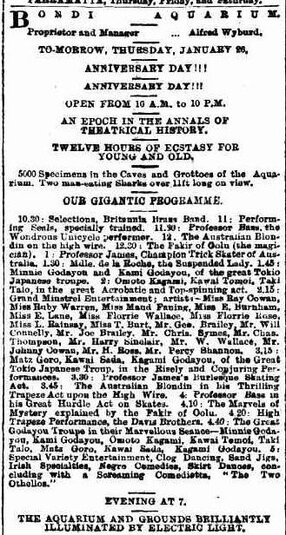 The years 1892 and 1893 may be summed up in almost a single sentence. The Silvesters were at the Bondi Aquarium. They became effectively resident performers, appearing with their magic as a host of variety acts passed through, including Kitchie the Wondrous Japanese Conjuror, Harry Fairfield walking the tightrope, Professor Wallace skating, and Sylvo the Egyptian Juggler. The Aquarium, though it had its up and downs, could host enormous numbers of visitors – on one day in January 1893, 13,000 patrons passed through the turnstiles before the evening performances.
The years 1892 and 1893 may be summed up in almost a single sentence. The Silvesters were at the Bondi Aquarium. They became effectively resident performers, appearing with their magic as a host of variety acts passed through, including Kitchie the Wondrous Japanese Conjuror, Harry Fairfield walking the tightrope, Professor Wallace skating, and Sylvo the Egyptian Juggler. The Aquarium, though it had its up and downs, could host enormous numbers of visitors – on one day in January 1893, 13,000 patrons passed through the turnstiles before the evening performances.1894 - NEW ZEALAND TOUR
As 1893 drew to a close, the Silvesters are seen in a very brief appearance in Wollongong, NSW during November, and then suddenly pop up, almost unannounced, in New Zealand. If they were hoping for a profitable tour, their dreams would be dashed – New Zealand was fairly much a disaster in any number of ways.
Opening at the Wellington Opera House for just three nights, on December 16, the audience was not large; and it has to be admitted that very little advance publicity had been given. Reviews were complimentary but unexcited – “Mr. Sylvester performed a number of sleight-of-hand feats with considerable dexterity / … the Professor was frequently applauded, and the entertainment evidently gave satisfaction to those present.” Days later it was reported, “The Fakir of Oolu very soon collapsed – only performing two nights and returning the money on the third night, fairly disgusted with the bare benches.”
They kept on the move, touring where they could, and gaps in their tour dates might be explained by appearances at townships so small that no newspaper publicity was given; or that they tried to take on other work at certain times.
Features of the show included Leo the Talking Lion, Masks and Faces, the Shadow pantomime, and curiously, the “Kalospinterchromokrene” or Fairy Fountain, which must have been far easier to transport and pressurise than in the days of the original Fakir.
For the year 1894, these are the dates identified: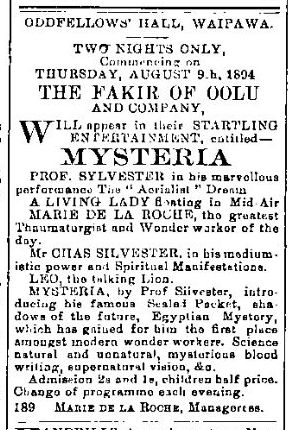

January 5 – Wanganui Oddfellow’s Hall – two nights or more
January 18 - Inglewood
January 22 – New Plymouth Alexandra Hall – two nights
May 6 – Auckland - Devonport Public Hall after previous weeknights in Auckland
June 25 – Poverty Bay Academy of Music – two nights
July 30 – Napier Stuart’s Hall
August 7 – Napier Working Men’s Club
August 9 - Waipawa Oddfellow’s Hall – two nights
August 20 – Woodville
September 6 – Benefit night at Masterton Temperance Hall
October 18 - Lyttleton Opera House
October [20] - Christchurch Opera House – first appearance of “Baby Ida (2 ½ years of age) the Premier Liliputian Contortionist.”
November from 1st – Christchurch - Canterbury Carnival week – “Mr Silvester attracts full audiences”.
In every case where a newspaper review was made of the show, the commentary was favourable; in fact, at Inglewood the writer said “the truth is I have never seen anything so clover before … truly wonderful performances.” Sometimes the attendance was good, several times a small audience was remarked upon, but always the performance was value for money.
LILIAN ZOE SILVESTER
The first calamity to hit the Silvesters was the loss of their new daughter, Lilian Zoe. It can be estimated (5) that Lilian was born in January 1894 and died in April or May. Eleanor had been noted performing the suspension illusion right through at the end of 1893 and into January, almost unthinkable in itself. The parents were travelling with five other young children aged between two and nine; though it may have been commonplace, in those years, to lose a child early in life, it cannot have lessened the grief felt while travelling in an unfamiliar country. Hard on the heels of this event comes another which seems to suggest that their finances were in a difficult state.
AUCKLAND COURT CHARGE
On Sunday, May 6, Charles was charged with having ‘worked at his calling as a mesmerist’ at the Devenport Public Hall. The strong inference from the newspapers was that Charles was presenting some kind of religious spiritual performance and invoked dramatic terms such as mesmerist, animal magnetism, and séance. Charles, in fact, was reported to have said that the performance was a spiritual séance.
Reading closely through the news report from the Police Court on May 17, (6) a more realistic view can be taken. A collection was taken at the door, no person being admitted without a contribution, and the first part of the evening was devoted to the Silvester’s performance. It is clear that what he performed was no more than he had been showing earlier during the week – the ‘mesmerism’ and ‘animal magnetism’ was the standard presentation for the Entranced Lady, and the usual mind-reading repertoire was gone through. The later part of the evening was indeed given over to singing and prayers. The defendant said that if he knew the thing was wrong, he would not have given it. Ultimately the charge was dismissed, with a caution.
Most telling about this story is that Charles was reduced to performing for nothing more than a plate collection. The report said that only four shillings and threepence was taken at the door, that the lessee of the hall had not charged for its hire on this occasion, and that “the man was very poor.”
POVERTY BAY
Less dramatic, but relevant to the story, is that the Silvesters were at Poverty Bay (Gisborne) on June 25 and 26 at the Academy of Music. Just a couple of months prior, another act had passed through, performing at the Theatre Royal. He was described as “A. Sylvester, Grandson of the late Dr. Sylvester, ‘Fakir of Oolu’ will give an exhibition of Legerdemain.”
This was, indeed, Alfred William Silvester, grandson of the original Fakir and son of Alfred2. It seems reasonable to speculate that Charles and Alfred3 might have met up somewhere in the area; certainly he toured with them in New Zealand and through to Australia in 1896. This connection will be re-visited when we examine the life of Alfred3 in a later chapter.
Lastly in connection with Gisborne is a report on June 26 saying “we hear that Mr. Charles Silvester, champion roller skater of Australia, intends to open the rink for the winter months, and will exhibit many novel and clever acts in roller skating.” There is no further evidence of this happening, but it might account for the sparse performances during those months, all of which took place on the east coast of New Zealand’s North Island.
CALAMITY IN MASTERTON
Distressing new was reported on September 4, 1894, in the Wairarapa Daily Times:
“There are many ups and downs in life, and the best of men sometimes meet reverses of fortune as severe, as unexpected and unmerited. Such has apparently been the experience of Professor Sylvester, better known as the “Fakir of Oolu,” a man who has reached the top of his profession as a wonder-worker, and who – in his palmy days – has delighted many a large audience, night after night, in some of the largest cities of the world. Latterly a series of misfortunes seem to have dogged his steps, and after a gallant fight against the inevitable, he found himself a week ago, with wife and six little ones, “stranded” at Masterton, with only one chance ahead, and that was a full house at his entertainment last night. But even the weather seemed against him, and the entertainment – one of the brightest of the kind ever given in Masterton – failed for want of support. By accident Mr. J.E. Hood discovered how bad matters really were, and that the Professor’s wife and children were really in need of the necessities of life, having neither food nor firing in the empty house they had taken, not having the wherewithal to stay at an hotel. Mr. Hood mentioned the state of things to a number of people, who at once took up the matter, and it has been decided to tender Professor Sylvester a complimentary concert on Thursday evening next, in which Pearson’s Brass Band, several leading amateurs and the Professor himself will take pare. We feel sure that on this occasion the Temperance Hall will be well filled.”
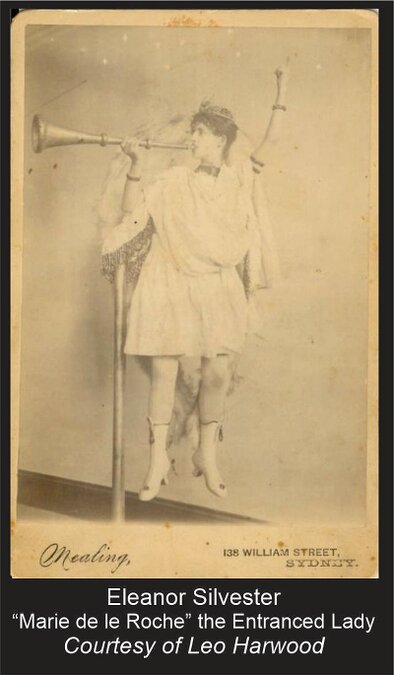
Indeed it was. The good people of Masterton (coincidentally, a town named after Mr. Joseph Masters, puppeteer and magician) rallied around.
September 7: “Fakir of Oolu – The Clouds Roll By. It has been said, “every cloud has a silver lining,” and the fact that at least some clouds are so built, has just been demonstrated in the case of Professor Sylvester and his Masterton experiences. When – after many reverses – he reached this town, and on the night of his first entertainment found that his last effort had apparently failed, his feelings may be better imagined than described. What followed is already known, how the Professor gallantly fought his battles; how Mr. J. E. Hood discovered the state of affairs, and how sadly in need of real assistance the Sylvester Family proved to be. The idea of the benefit entertainment, which took place last evening, was soon started, and support from all quarters was offered most readily, and even at such a short notice it is not therefore surprising that the Temperance Hall was packed in every part.
The entertainment opened with an Overture by the Masterton Orchestra, most creditably performed, after which followed a song, “The Wolf,” by Mr. S. Ralph, who was obliged to respond to an encore. Mr. Winsley next sang “The Breath of Life” in a very pleasing manner, and being excellent voice came in for much applause, and was encored.
Miss May Sylvester [ie, Elinor May] – the tiny daughter of the Professor – next appeared, and quite delighted everybody with her charming singing of “The Old Folks at Home,” and later in the evening by special request sang “Daisy Bell.” Some comic songs, which seemed to suit the audience, were well rendered by Mr. J. Light, after which Captain Fred Thomas sang “Queen of the Earth,” his fine voice being heard to advantage in this favorite song. Encored, he gave one of his original funny stories, in that style and manner which has made his name famous throughout this district, keeping everybody in roars of laughter, with his account of a Melbourne Cup incident.
An interval of ten minutes succeeded, and then the Professor was introduced by Captain Thomas, and most heartily greeted by the audience. Some clever hat-tricks, vanishing performances, and general sleight-of-hand work was rapidly and cleanly performed, proving Professor Sylvester to be a wizard of no mean order, while Madame de la Roche ably assisted and - as is usual with the sex – did most of the talking, keeping the audience in a bubble of good humour. A sketch entitled “The Evening [unclear]” by the Professor, gave an example of his versatility, and showed that cornet playing must also be reckoned amongst his accomplishments.
The entertainment concluded with a special feature of really marvellous interest, in which Madame de la Roche, suspended in the air on the point of a sword, becomes a rigid figure, remaining in any position directed by the Professor. His artistic posing of the lady called forth loud applause, and evoked lots of curiosity as to how it was done, but although the Professor explained a good many of his illusions [pseudo-explanations a la the original Fakir’s act] this most weird and startling performance remained a mystery.
In bowing his adieu, Professor Sylvester spoke most feelingly of the treatment he had received in Masterton, and specially mentioned the kindness of Mr. J. E. Hood and Pearson’s Band. Many others, including Capt. Thomas, Mr. Geo. Gray, and even people he did not know, had come forward, unasked, to render assistance, in a manner he should never forget. He was also deeply indebted to several ladies, particularly Mrs. Mandel of the Club Hotel, and Miss Williams, of the Occidental, to whom were due his heartfelt thanks for many kindnesses to his wife and little ones. Again thanking everybody for real practical sympathy, the Professor, quite unable to further express his feelings, quitted the stage amidst a tumult of applause. Professor Sylvester sends us a letter of thanks ….”
1895 – NEW ZEALAND – WESTERN AUSTRALIA
Relatively little can be said of the continuing tour in New Zealand, other than that business seems to have picked up to some degree, and advertising was more frequent. The list of venues played, however, was with few exceptions made up of very small towns indeed, mostly around the lower end of the South Island where, even today, some are little more than a junction of two roads. In July (7) the Chronicle said “When one remembers that Professor Sylvester has drawn large crowds in the leading cities of the world, it seems somewhat remarkable that he should be attracted to such a modest little place as the Sowburn [region] and the only solution of the question is that our spare “bobs” are quite as welcome as those of other places, and as money is said to be scarce everywhere at the present time acting celebrities have to travel anywhere where they can find it …”
In February the Silvesters’ advance agent parted ways with the troupe (Eleanor took over the agent duties), and he was left “stranded and stone-broke” at Dunedin. Failing to pay his hotel bill, he impersonated a race-course “bookie” and started taking bets at the local Jockey Club, before running out of town.
Also at Dunedin the press said “the only matter to which exception can be taken is the introduction of the three little girls who appear to be too young to perform in public.” Indeed, both Vera and Ida were under five. The show was now being billed as “The Silvester Family”, and since a troupe of eight is regularly mentioned, it seems that Alfred William Silvester had joined up and was working with the show.
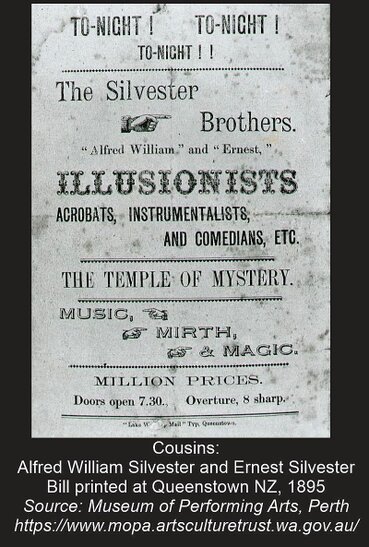
February 1 - Miller's Flat - Eady's Hall (benefit to Mrs Bowman)
February 11-12 - Kaitangata – “not patronised as largely as it might have been.”
February 22-23 - Gore Town Hall – “houses on both evenings very small ... deserving of better.”
March 6-8 - Invercargill Royal with Gourlay-Stokes combination
March 21 - Riverton
March 22 - Colac Bay
March 23 - Orepuki
April 3 - Riverton return – “both nights audiences were very small, barely enough to cover expenses.”
April 23 - Queenstown Town Hall
April 27 - Arrowtown
April 30 - May 1 - Cromwell Athenaeum Hall - fair house
May 3 - Clyde
May 4 and 6 - Alexandra - full house both nights
May 7 - Ophir
May 8 - Matakanui
May 9 - St. Bathans
June 29, July 2-6 - Dunedin City Hall - "just completed a successful tour of the goldfields"
July ? - Middlemarch – “owing to the bad state of the roads ... not so well attended.”
July ? - 'The Sowburn' near Patearoa
August 6 - Clifton
August 29 - Bluff
August 30 - Wright's Bush
After August, no more is seen of the Silvesters either in New Zealand or Australia, until in early December when the troupe arrived in a most unexpected place – Perth, Western Australia.
“Ye Old Englishe Fayre Carnival and Open Air Concert” opened on December 14. It appears to have been a theatrical company’s venture, rather than a civic celebration. Amongst the performers were vocalists including Miss Ettie Williams, Pearl Akarman the contortionist, George Jones eccentric comedian, Professor Segue with swordsmanship, and of course the Fakir of Oolu and Marie de la Roche ‘the greatest living wonder worker of the age.’
Quite why Charles and Eleanor had chosen to take a chance on Western Australia is a mystery. As their brother Alfred had already discovered, the small population size put a touring show up against difficulties from the start. Perhaps they hoped to manage well with an audience which had not previously seen their acts. With the ‘Fayre’, indeed, they did have success and the people turned out in good numbers – in fact, the Fayre continued right through to the start of March, 1896, adding various other performers such as Professor Soquet who, along with showing his performing monkeys, put his head inside a bear’s mouth.
1896 - DEMISE AND DESTINY
The Silvesters followed the Fayre to Fremantle in early March, but soon headed off on their own, appearing at the Mechanics’ Hall in Guildford, where the cast was listed to include Baby Vera, Miss May Silvester, Master Ernest Silvester, Little Ida Silvester, and Mr. A.W [ie, Alfred William] Silvester. A new feat was added, the “Decapitation Scene, in which the Professor pulls a living boy to pieces, in full view of the audience, and passes the Boy’s Head around for examination.” Like the head, we will pass on from that ... quickly.
Ernest Silvester was now a Cornet soloist, while May was a ‘charming soprano’ and Baby Ida was ‘the child wonder’ possibly performing some kind of mind-reading feat at less than three years of age. The tour was scheduled to run through to Albany, playing at Guildford, York, Beverley, Northam, Newcastle and Bunbury, and by March 28 they had been at Katanning playing to a packed house. They returned to Perth in May for a benefit night to Mr S. Marks, and then set out again for Jarrahdale, Pinjarrah and Bunbury up to June 1.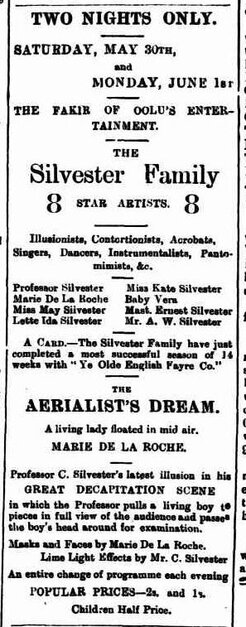

At Bunbury, the show opened but the weather was so bad that the performance had to be cancelled and money was returned, and the next show had to wait while another group hired the hall. The Bunbury Herald reported, “Even if the Hall had not been engaged, Mr. Silvester was too ill to go through with the performance. He is, we regret to say, still under the doctor’s care, and when he recovers from his illness, purposes giving a performance, the date of which will be advertised in the The Herald.”
Charles did not recover. On the morning of June 5, suffering from pleurisy (inflammation of the lungs), he died, aged just 38. (8) He left behind him a wife and young family, completely destitute.
Mr. George Jones of the Ettie Williams company announced a benefit performance, supported by the entire company to support Mrs. Silvester, and on June 9 the Masonic Hall was full, to watch a programme of songs, stump speeches and recitations, raising £32 for the immediate needs of the family, who now returned to Perth. Eleanor was, by mid-June, in very distressed circumstances, and a subscription was announced in the ‘Western Mail’ to assist, followed by another benefit night at the Cremorne Theatre on July 22, for which the offers of assistance were so numerous that some difficulty was experienced in creating a final running order. (9) The house was crowded:
“A noteworthy incident of the evening was the appearance on the stage of the three children of the deceased, who sang the popular song ‘Molly Riley.’ The little ones were encored, and on their reappearance someone in the audience set the example by throwing a coin on the stage, and for a few minutes afterwards there was a shower of silver pieces of every denomination of value, which were eagerly gathered up by the children … it was announced that there would be practically no expenses in connection with the performance and … the amount realised … would be a handsome sum.”
And so Eleanor Silvester was left to make her way in life. Marie de la Roche was seen no more. Alfred William Silvester, who returned to New Zealand, may have taken away the show properties including the Entranced Lady mechanism. With true grit, however, Eleanor established herself in the Perth suburb of Subiaco, living at 80 Townshend Road and running “Mrs. Silvester’s Cash Store” just a block away at 313 Hay Street. From this time on, Western Australia became the home of generations of Silvester descendants.
From about 1899, Eleanor organised an annual ‘plain and fancy dress ball’ at the King’s Hall, which continued until at least 1908, and she was reported to also give tuition in dance. Eleanor Georgina Whaley/Silvester died on February 2, 1920. She is buried at Karrakatta Cemetery.
That would seem to bring to an end this branch of the Silvester performing family. Nothing could be further from the truth. Charles and Eleanor’s daughter, Vera Whaley Silvester, would become the next generation of magical Silvesters, embarking on a decades-long career which took her in astonishing directions. That story is yet to come.
>>> Chapter Nine
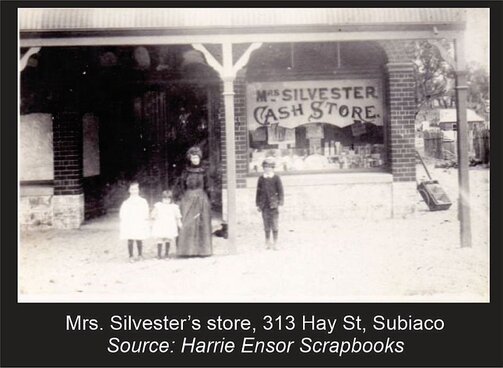

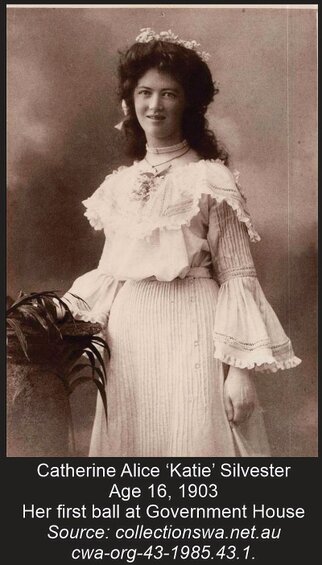
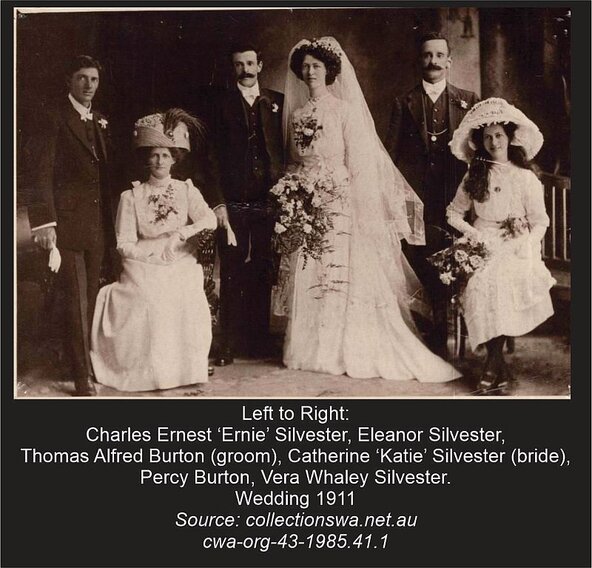

REFERENCES FOR CHAPTER EIGHT
(1) Children of Eleanor and Charles Silvester:
[1884] Charles Ernest. He enlisted in the Australian Imperial Force in October 1916, describing his profession as “Horse driver” of Townshend Rd Subiaco. Divorced his wife, May Alice Silvester in 1922 on grounds of her infidelity. Died September 16, 1946 as husband of Mary Elizabeth, and is buried at Karrakatta Cemetery W.A.
1885 Elinor May. Known as Elly [see Wikitree], married in 1921 to James Thomas Goodlet, a builder, who served at Gallipoli and was gassed but survived to fight in WW2. See https://www.jbmilitaryantiques.com.au/product/book-28th-bn-a-record-of-war-service-1915-1919-vol-1-colonel-hb-collett-ww1/ for an inscribed war record book. Elinor died August 13, 1939 and is buried at Karrakatta Cemetery. Her niece, Ida Silvester/Harwood, wrote "May had a very good soprano voice and sang with the J.C. Williamson organisation for many years before she met and married Jim Goodlet."
1887 Catherine Alice “Katie”. Married Thomas Alfred Burton in December 1911 and died April 23, 1982. She is buried at Karrakatta Cemetery.
1890 Ida Hillgrove. The name ‘Hillgrove’ came from the town near Armidale where the family was living. She died at age 11 years 9 months on February 7, 1902 "after a long and painful illness". Buried at Karrakatta Cemetery.
1892 Vera Whaley – [‘Whaley’ being her mother’s maiden name]. Refer to details in the main story. Vera became the performer of the family and continued the family line of performing Silvesters through till the present day.
1894 Lilian Zoe. She died aged less than one year, possibly born in January [Ancestry.com], and is buried at the Waikumete Cemetery, Glen Eden, Auckland. The family were in Auckland in May 1894.
1896 Horace Claude. He died aged less than one year; any interment site is unknown.
(2) Telegraph, St Kilda, Prahran and South Yarra Guardian, August 6 1887
(3) https://www.stagewhispers.com.au/history/how-ambition-ruined-early-aussie-champion-local-talent by Leann Richards.
(4) Sydney Morning Herald, June 11 1888 p.5.
(5) Ancestry.com states a birthdate of January 1894 for Lilian Zoe Silvester. She is buried in Auckland, where the Silvesters were located in May.
(6) Report of court proceedings in the Thames Star, May 18, 1894. p.2.
(7) Mount Ida Chronicle July 13, 1895.
(8) Charles’ burial place, for some reason, cannot be located, but is presumably at either Bunbury or Perth. Eleanor, though we have followed the known spelling, was reported as “Elinor” in death notices of February 1920.
(9) The West Australian, July 23, 1986 p.5